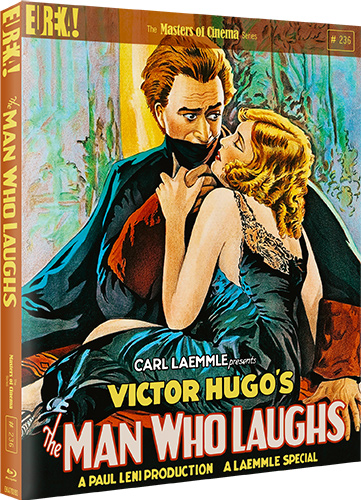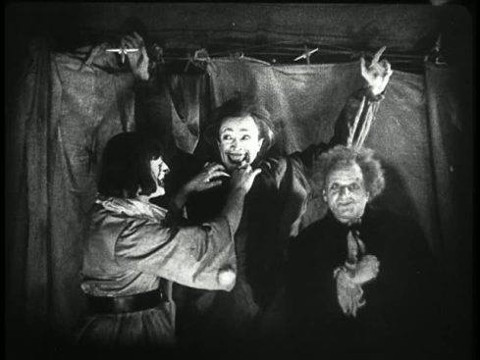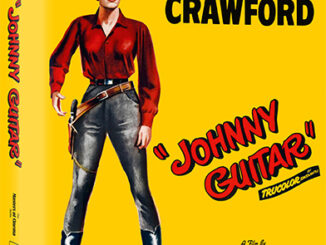The Man Who Laughs (1928)
Directed by: Paul Leni
Written by: Charles E. Whittaker, J. Grubb Alexander, Marion Ward, May McLean, Victor Hugo
Starring: Conrad Veidt, Julius Molnar, Mary Philbin, Olga Baclanova
USA
AVAILABLE ON BLU-RAY: NOW, from EUREKA ENTERTAINMENT
RUNNING TIME: 110 mins
REVIEWED BY:Dr Lenera
1680’s England; King James II sentences Lord Clancharlie to death and Clancharlie’s son Gwynplaine to be disfigured with a permanent grin, then exiled. Gwynplaine rescues a blind baby girl, Dea, and grows up to become the Laughing Man, the freak show star of a traveling carnival, and a man who feels unworthy of Dea’s love due to his disfigurement which she cannot see. Meanwhile the jester Barkilphedro discovers Gwynplaine’s real lineage and rightful inheritance. That estate is currently possessed by Duchess Josiana, who seems to actually be drawn to Gwynplaine’s grin….
Smiling usually makes you feel good, but imagine being stuck with a smile that never ever goes away? Such a problem is born by the title character in this silent classic, a character that even a glance at the poster would tell you was a major inspiration for Batman’s most popular opponent the Clown Prince of Crime. And such a problem was also faced by its star Conrad Veidt [immortalised as Major Strasser in Casablanca but also a major star of German silents and somebody who almost played Dracula in the 1930 version], who was required to display emotion while being severely restricted. He’d already proved his skill at performing mime as the somnambulist Cesare in The Cabinet Of Dr. Caligari, but the role of Gwynplaine required something totally different. Amazingly, Veidt totally delivered, largely using his expressive eyes, in a simply amazing performance which is now hands down one of very best I’ve seen in a silent movie. But then the whole film, one I hadn’t seen before and one that I knew little about, is pretty impressive, and might serve as a good introduction to those who haven’t seen a silent movie, largely because it’s so damn entertaining. While it may seem like it’s going to be a gloomy Gothic romance, and certainly has aspects of one resulting in some incredibly touching moments [you won’t believe how much emotion this film will make you feel], it’s really got a bit of almost everything; tragedy, romance, comedy, court intrigue, sex including one of the oddest ‘love’ scenes I’ve ever seen in a really old movie, and a big-scale, lengthy action finale.
It was based on a Victor Hugo novel which had already been filmed twice and would subsequently be filmed again three times as well as be adapted for other mediums. The originally intended star was Lon Chaney, who’d just had a big success as Hugo’s The Hunchback Of Notre Dame. A treatment adapting Gaston Leroux’s The Phantom Of The Opera was prepared, but rejected by the Universal executives, so Chaney was offered the lead in The Man Who Laughs, to be produced under its French title L’Homme Qui Rit out of perceived similarity to the ever-popular Les Misérables. But Universal failed to acquire film rights so Chaney’s contract was amended, releasing him from The Man Who Laughs, but permitting him to name the replacement film, which turned out to be The Phantom of the Opera. After that was a hit, Universal returned to The Man Who Laughs, this time with the rights and a very high budget, with Conrad Veidt replacing Chaney and Paul Leni, whose The Cat And The Canary had recently been successful, to direct. The person responsible for crafting Gwynplaine’s appearance was Jack Pierce, later to create the iconic makeup for Boris Karloff’s Frankenstein Monster and many others. The script by J. Grubb Alexander, Walter Anthony, Mary McLean and Charles E. Whittaker was fairly close to the novel but removed its flashback structure and amended its downbeat ending. During the sequence where Gwynplaine is presented to the House of Lords, the extras were so moved by Veidt’s performance that they burst into applause and asked for an encore. Only a lukewarm success, it was re-released with sound effects, a synchronized score, and a theme song entitled ‘When Love Comes Stealing’, then became hard to see for many decades.
We open with King James asleep in bed while the camera cuts to several rather menacing statues in his bedroom. Just as one wonders what they’re doing there, one of them moves, and out of it comes Barkilphedro the court jester, one of several pretty grotesque-looking characters who populate this world. We’re also reminded that, while this isn’t really a horror film, we’re still partly in the world of German Expressionism; there’s nothing as extreme as you get in, say, Metropolis or The Golem, but there’s still loads of moody lighting with darkness deliberately obscuring areas of the screen and the odd architectural oddity. Barkilphedro has come to tell his king that Lord Clancharlie has been captured. What’s his crime you may ask? Failing to kiss James’s hand. James tells him that his son Gwynplaine has been disfigured by having a permanent grin carved on him, so that he will “laugh forever at his fool of a father”. The doer of this dreadful deed is a “Comprachico”, a bandit who buys children and changes their physical appearance. Clancharlie is then put into an iron maiden and killed, and I didn’t think that iron maidens were used for another century or so, but never mind. I think that silents can get away with more historical inaccuracy to modern eyes, because they don’t seem realistic in the first place what with the lack of dialogue and speeded up film. James decides to get rid of the Comprachicos too and in their flight they leave little Gwynplaine behind in the snow, and now we get a great image of the boy walking past some hanging bodies. He finds the also young Dea who’s mother has died of hypothermia, but the two struggle to survive until taken in by Ursus, a carnival philosopher and a writer of plays who’s better than Shakespeare – so he claims. The first ten minutes are totally gripping and I did wonder if the rest of the film was going to live up to them!
Cut to what seems like 20 years later, and Ursus’s pet wolf Homo probably shouldn’t still be alive, but never mind. Dea, now played by The Phantom Of The Opera‘s Mary Philbin, and especially Gwynplaine are now popular carnival attractions. We see her tenderly stroking his shoulder as he’s about to get up on stage, and of course he’s got a great big smile, but one look at his eyes tells us that he’s not happy whatsoever and is really hurting. He loves her just as she loves him, but keeps shirking her. It’s clear that he’s afraid of physical intimacy with her, because, even if she can’t see it, she’ll still realise the extent of his deformity. At least he’s making a living, but it’s a living that consists of crowds of people jeering at his appearance. Meanwhile back in court, Queen Anne is now in charge, but Barkilphedro is still around, scheming. A Dr. Hardquanonne tells Barkilphedro Gwynplaine’s true identity. He should be living in a large estate which Duchess Josiana is residing in. Played by Olga Vladimirovna Baklanova who played a not entirely dissimilar role in Freaks, she’s brilliantly introduced teasing Barkilphedro with her legs, then kicking him onto the floor. Barkilphedro decides to tell a few others but not the Duchess herself. However, she soon comes across Gwynplaine anyway. She doesn’t seem to like hanging around with the rich folk very much, preferring to mix with the commoners, adding a nice shade to what is otherwise a typical silent film ‘vamp’ character. She sees Gwynplaine on stage, then has to return to a court gathering where half the people seem to be thoroughly bored, in one of several amusing touches of a similar nature that slightly pertain to the class commentary and criticism of royalty which Hugo apparently put into his novel.
Josiana sends Gwynplaine a pretty blatant note to come visit her, leading to a strange seduction scene where she actually seems to be turned on by Gwynplaine’s appearance while, for his part, Gwynplaine understandably finds it hard to resist despite not liking being touched ‘there’; after all, sex is probably something he’s never experienced, and we sympathise with him even though he’d be cheating on Dea. Frank and a little perverse, it’s a good reminder of what the movies lost when the Production Code suddenly got terribly strict in 1934 and sexuality in Hollywood movies had to become very chaste even if some of the cleverer filmmakers did their best to get around this. By comparison, it’s followed by a reunion scene so tender and beautiful it almost made me cry, actually aided by the use of the soppy theme song in the re-release version which is the one I watched, Eureka’s disc offering both that and a totally silent version with a much more recently composed score. However, soldiers then turn up to arrest Gwynplaine – or so it seems? Our hero soon has to decide what is more important and, even if the result is never really in doubt, there are still a few turns in what is a solid plot, one or two of them rather silly – but then this is, at its heart, a melodrama first and foremost. And the final act offers much chasing, a battle in the streets, a sword fight, Gwynplaine dashing about the rooftops which is the only real time he seems like a conventional movie monster seeing how many films ended with their monster dashing about the rooftops, and probably a couple of other things I’ve forgotten. It rounds off a very well paced film very well.
There’s some experimentation with extended dissolves so several things are happening in the frame all at once, while, outside of the court scenes, this film really does look liked an archetypal Universal horror from the early ’30s, not surprising really with Charles D. Hall as the set designer. But it’s also so rife with simple feeling. Leni likes to dwell on characters waiting, worrying; far from slowing things down, it makes us care for these people. The only thing that niggled me a few times is that the story presents Gwynplaine’s speech as being clear enough to be understood by all other characters without impediment. Since Gwynplaine cannot close his lips, he would in reality be almost mute, as indeed Veidt was whenever wearing the Gwynplaine prosthesis, a highly uncomfortable device that distended his mouth while supplying grotesque teeth. But seeing as we’re watching something that can’t offer a realistic approximation of sound anyway, it’s probably not a big deal really and I’m no doubt just being picky. Most of the time I was just transfixed by Veidt’s acting; he’s able to show happiness, sadness, lust, hate, whatever – by just his eyes and his body language. It’s therefore not surprising that he was able to go on to do well in sound pictures when many silent stars floundered because they had to get rid of the exaggerated mannerisms that they’d been so used to using. Sadly he died at age 50, while Leni himself died at 44 the year after The Man Who Laughs was released, from sepsis brought on by a tooth infection. Judging by this particular film, the movie world lost a major talent far too early, though he left us a few other films that I’m going to check out. After watching The Man Who Laughs, you may feel like doing the very same thing.
Rating: 









SPECIAL FEATURES
*LIMITED EDITION O CARD (2000 UNITS)
*1080p presentation on Blu-ray from Universal’s 4K restoration
Eureka seem to be using the same restoration as the film’s North American distributors on Blu-ray Flicker Alley. Universal’s digital clean-ups have a very high reputation and rightly so judging by this example; I have never seen a silent movie that looks as good. Of course there are a few instances of print damage but they are few and far between. The contrast is amazing and even the blacks are impressive, with very little crush.
*Uncompressed LPCM 2.0 (stereo) score by the Berklee School of Music
While I watched the whole film with the 1928 music score, I did subsequently check out portions of this alternate soundtrack from the Berklee School of Music. It’s more like a conventional silent film score, and has more diversity than the 1928 score, with even some lighthearted music, while obviously being in better quality sound.
*Uncompressed LPCM 2.0 (mono) 1928 movietone score
I still preferred this other track, even though some of its themes seemed to be from other movies and the recording is very old. I’m not sure I’d want to watch the film without that song; that was a major part of my first experience with this striking work. I’m sure others may find it cloying though. What can I say; I’m a sentimentalist.
*Kim Newman on Paul Leni – a brand new interview with author and horror expert Kim Newman [12 mins]
Perennial Eureka contributor Kim Newman presents a good case for Leni being highly overlooked, says how he would have become a major horror director, and presents us with a tantalising might-have-been; Veidt playing Dracula directed by Leni. Newman’s wearing that crazy waistcoat with old ‘B’ movie posters on it again.
*The Face Deceives – a brand new video essay by David Cairns and Fiona Watson [33 mins]
A special effort seems to have been made to put together this particular video essay, with excerpts from the novel, plus quotations from Veidt, Leni and others being read out including Hall’s great grandnephew Matthew Charles Hall who tells recollections from Hall about Leni. We learn that Veidt came to America because he was invited by John Barrymore to be the villain in his current production, plus a bit more about Leni’s career and the production of The Man Who Laughs. Informative and with a rather strong mood about it.
*Paul Leni and “The Man Who Laughs” – featurette on the production of the film [13 mins]
This is from the Flicker Alley release and covers some of the same ground as the previous featurette, but we do get a bit more detail about some of Leni’s other films.
*Rare stills gallery
*A collector’s booklet featuring new writing by Travis Crawford, and Richard Combs








Be the first to comment